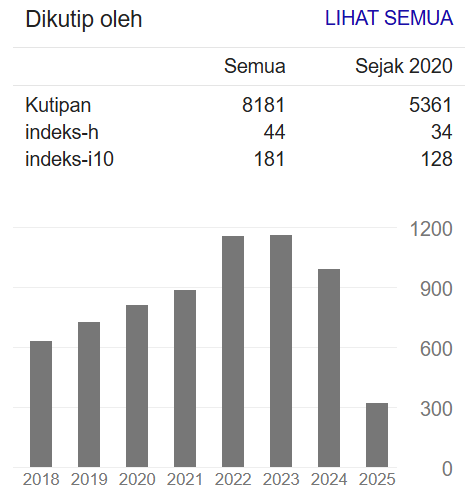KAJIAN TENTANG PENURUNAN JUMLAH DONOR DARAH AKIBAT PANDEMI COVID-19: DATA SELAMA 4 TAHUN DARI UDD PMI KOTA PONTIANAK
DOI:
https://doi.org/10.34011/jmp2k.v32i4.1890Keywords:
blood donors, COVID-19 pandemicAbstract
The COVID-19 pandemic has left a noticeable mark on the health care sector. One such example is the blood services provided by the Blood Donor Unit (UDD) of Indonesian Red Cross (PMI). Every time there was an increase in COVID-19 cases, blood donation activities sharply decreased, according to the UDD PMI. During the COVID-19 pandemic, there was a scarcity of blood donors. This research aimed to see the difference in the number of blood donors before and during the pandemic. This research was descriptive analytical with a cross-sectional design by collecting data on the number of blood donors at UDD PMI Pontianak City from 2018 to 2022. The results of the study show that the number of blood donors before the pandemic was 52,607 donors, while the number of blood donors during the pandemic was 48,421 donors. which means there was a decrease in the number of blood donors by 4,186 donors (7.96%). The Independent Samples Test obtained a significant value of 0.045 (p < 0.05), which means there was a difference in the number of blood donors before and during the COVID-19 pandemic at UDD PMI Pontianak City. Concerns about the risk of infection and government policies limiting activities outside the home can explain why the COVID-19 pandemic has resulted in a decline in blood donation rates.
References
M. Mohamadian, H. Chiti, A. Shoghli, S. Biglari, N. Parsamanesh, and A. Esmaeilzadeh, “COVID-19: Virology, biology and novel laboratory diagnosis,” J Gene Med, vol. 23, no. 2, p. e3303, Feb. 2021, doi: 10.1002/jgm.3303.
R. Ochani et al., “COVID-19 pandemic: from origins to outcomes. A comprehensive review of viral pathogenesis, clinical manifestations, diagnostic evaluation, and management,” Infez Med, vol. 29, no. 1, pp. 20–36, 2021, [Online]. Available: http://europepmc.org/abstract/MED/33664170
W. Wang, J. Tang, and F. Wei, “Updated understanding of the outbreak of 2019 novel coronavirus (2019-nCoV) in Wuhan, China,” J Med Virol, vol. 92, no. 4, pp. 441–447, Apr. 2020, doi: 10.1002/jmv.25689.
I. Chakraborty and P. Maity, “COVID-19 outbreak: Migration, effects on society, global environment and prevention,” Sci Total Environ, vol. 728, p. 138882, Aug. 2020, doi: 10.1016/j.scitotenv.2020.138882.
D. Cucinotta and M. Vanelli, “WHO declares COVID-19 a pandemic,” Acta Biomedica, vol. 91, no. 1, pp. 157–160, 2020, doi: 10.23750/abm.v91i1.9397.
B. Nugraha, L. K. Wahyuni, H. Laswati, P. Kusumastuti, A. B. Tulaar, and C. Gutenbrunner, “COVID-19 pandemic in Indonesia: Situation and challenges of rehabilitation medicine in Indonesia,” Acta Med Indones, vol. 52, no. 3, p. 299—305, Jul. 2020, [Online]. Available: http://europepmc.org/abstract/MED/33020342
N. Al-Awwal, F. Dweik, S. Mahdi, M. El-Dweik, and S. H. Anderson, “A Review of SARS-CoV-2 Disease (COVID-19): Pandemic in Our Time,” Pathogens, vol. 11, no. 3, p. 368, Mar. 2022, doi: 10.3390/pathogens11030368.
K. K. Leung et al., “Effectiveness of containment strategies in preventing SARS-CoV-2 transmission,” J Infect Public Health, vol. 15, no. 6, pp. 609–614, Jun. 2022, doi: 10.1016/j.jiph.2022.04.012.
T. Ilham, S. Akbar, M. Sayuti, and M. Ikhsan, “The Impact of the COVID-19 Pandemic on the Number of Blood Donors in the Blood Transfusion Unit of the Indonesian Red Cross of Banda Aceh City,” Bulletin Farmatera Faculty Medicine, vol. 7, no. 2, pp. 14–20, 2022, [Online]. Available: http://jurnal.umsu.ac.id/index.php/buletin_farmatera
B. Veseli, S. Sandner, S. Studte, and M. Clement, “The impact of COVID-19 on blood donations,” PLoS One, vol. 17, no. 3, p. e0265171, 2022, doi: 10.1371/journal.pone.0265171.
N. W. Astuti, N. Purnamaningsih, and T. Sunarsih, “Overview of Blood Stocks and Demand During the COVID-19 Pandemic in Blood Donation Unit PMI Sleman Yogyakarta,” Jurnal Profesi Medika : Jurnal Kedokteran dan Kesehatan, vol. 15, no. 1, pp. 69–75, Jun. 2021, doi: 10.33533/jpm.v15i1.2910.
C. Wang et al., “A longitudinal study on the mental health of general population during the COVID-19 epidemic in China,” Brain Behav Immun, vol. 87, pp. 40–48, Jul. 2020, doi: 10.1016/j.bbi.2020.04.028.
Y.-J. Kim and J.-H. Cho, “A study on blood donor characteristics and preferred environment of South Koreans during the COVID-19 pandemic: A conjoint analysis,” Front Public Health, vol. 11, p. 1138430, 2023, doi: 10.3389/fpubh.2023.1138430.
D. Chenna, D. Kandasamy, G. Mohan, K. C. Pentapati, and S. Shastry, “A survey on insight of blood donors during COVID pandemic in Southern India,” Hematol Transfus Cell Ther, vol. 45, no. 4, pp. 442–448, Oct. 2023, doi: 10.1016/j.htct.2022.07.009.
Y. Ng, C. Tong, W. Tsoi, and C. Lee, “Frequencies of ABO and RhD blood groups among blood donors in Hong Kong,” Ann Blood, vol. 8, p. 33, Dec. 2023, doi: 10.21037/aob-23-6.
P. Rianti, Z. R. Mardliyah, and D. D. Solihin, “Diversity of ABO blood groups, ethnic groups, and medical histories of university students in Indonesia,” Jurnal Natural, vol. 23, no. 3, pp. 174–184, Oct. 2023, doi: 10.24815/jn.v23i3.30596.
H. A. Waggiallah, “Blood Donation Knowledge, Perceptions, and Practices during COVID-19 Pandemic: Questionnaire-Based Study in Saudi Arabia,” Biomed Res Int, vol. 2023, p. 3911907, 2023, doi: 10.1155/2023/3911907.
P. P. Tripathi, V. Kumawat, and G. K. Patidar, “Donor’s Perspectives on Blood Donation During Covid-19 Pandemic,” Indian Journal of Hematology and Blood Transfusion, vol. 38, no. 3, pp. 536–545, Jul. 2022, doi: 10.1007/s12288-021-01504-y.




